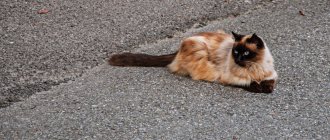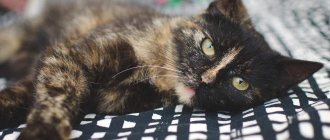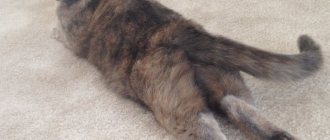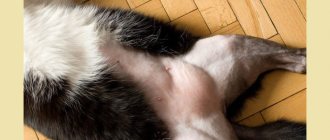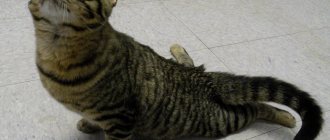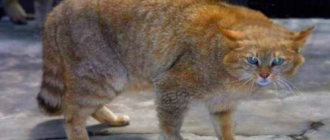There are many reasons why a cat’s hind legs fail – from mechanical injuries to fibrocartilaginous embolism. The disease can occur due to kidney pathology, heart disease, including strokes, vitamin deficiencies, and poisoning. Paralysis of the hind limbs in pregnant cats is often associated with fetal pathology or an imbalance of nutrients in the diet.
If a symptom is detected, a comprehensive diagnosis at a veterinary institution is necessary. Treatment depends on the root cause of the disease and includes not only drug therapy, but also surgery.
The cat's hind legs have failed: causes and auxiliary symptoms
If a cat's hind legs fail, then the causes of the symptom are usually serious - injuries to the spinal column, the formation of a blood clot in large vessels, kidney failure, neurological diseases.
Spinal injury
One of the common causes of limb failure in cats is spinal injury. Animals fall from heights, fall into the clutches of dogs, fight with relatives, end up under the wheels of cars, receiving various spinal injuries. Damaged nerve endings do not transmit impulses from the muscles to the brain, and the owner discovers that the cat’s paws have failed.
As a rule, the symptom occurs immediately after injury and is accompanied by painful shock. The animal often loses consciousness. In most cases, motor function is not restored.
Spinal fracture
The cat's front legs give way as a result of vitamin deficiency
A cat's front legs may become weak as a result of vitamin deficiency; most often this symptom accompanies rickets in young animals. With a lack of vitamin D, the processes of adsorption of calcium ions by bone tissue are disrupted, which leads to weakness of the musculoskeletal system. In this case, the front legs may give way due to a weakening of the chest.
With rickets, pets may experience weakness in the hind limbs and incorrect positioning. Symptoms of vitamin deficiency include dry skin, convulsions, and cachexia.
We recommend reading about a spinal fracture in a cat. You will learn about the causes and types of spinal fractures, symptoms, diagnosis and treatment.
And here is more information about why a cat is limping on its paw.
The cat drags its back paw due to a bruise
Having discovered that a cat is dragging its hind paw, you should rule out a bruise, because active and inquisitive animals often receive minor injuries while chasing rodents or birds, jumping from a high cabinet, running away from enemies, or falling from a height. In case of a bruise, restoration of the motor function of the paw occurs, as a rule, after 2-3 weeks, depending on the degree of damage to the soft tissues.
A cat crouches on its hind legs when walking due to thromboembolism
Often, a cat crouches on its hind legs when walking due to blockage of large arteries - thromboembolism. In this case, the pet experiences gait disturbance, lameness, and movements become uncoordinated. In acute cases, paralysis of the limbs develops.
Upon palpation, it is found that the muscles are tense and hard. The paw pads of arterial thromboembolism become pale due to impaired blood flow in the hind limbs.
The cat's hind legs are dragging as a consequence of a stroke
The reason that a cat’s hind legs drag is often the consequences of a stroke: due to impaired blood flow in the vessels, they become blocked, which is accompanied by progressive paralysis of the hind limbs in animals. The disease usually affects old animals that are prone to obesity and lead a sedentary lifestyle.
Weakness in the hind legs of a cat due to kidney failure
A common cause of weakness in the hind legs of a cat is kidney failure - severe intoxication as a result of impaired kidney function, a change in blood pressure is accompanied by the fact that the animal drags its hind legs. In case of renal failure, there is also a decrease in appetite, increased thirst, impaired urination (up to the absence of urine), drowsiness, unpleasant odor from the mouth, and vomiting.
Due to inflammation of the spinal cord, the cat's hind legs collapse
The reason why a cat's hind legs collapse may be an inflammatory process in the spinal cord, which is often caused by parasites or infectious diseases.
The cat's hind legs are buckling due to fibrocartilaginous embolism
The reason why a cat's hind legs buckle is often due to fibrocartilaginous embolism; the disease is a type of thromboembolism. In pathology, the vessel is clogged with a fibrocartilaginous embolus, which is formed from the nucleus pulposus of the intervertebral disc. Symptoms can be minor - in the form of loss of sensitivity in the hind legs, or lead to complete paralysis of the hind legs.
A veterinarian usually supplements a neurological examination with an MRI.
Fibrocartilaginous embolism on MRI
The cat doesn't step on its hind paws
In some cases, a cat will not step on its hind legs if there is heart failure. In advanced cases, heart disease is accompanied not only by characteristic symptoms - shortness of breath, cyanosis or anemia of the mucous membranes, decreased appetite, fatigue, but also due to impaired blood circulation, paresis and even paralysis of the limbs develop. This phenomenon often accompanies cardiomyopathy.
The cat drags its hind legs and sways
If the cat drags its hind legs and sways, then the owner needs to rule out poisoning. When the body is intoxicated, metabolic products are not excreted and enter the blood, which leads to disruption of the conduction of nerve impulses. In case of poisoning, an animal experiences symptoms such as vomiting, increased salivation, diarrhea, dehydration, and convulsions.
Watch this video about the causes and symptoms of weakness and paralysis of the hind limbs in cats:
Pregnant cat stretches her hind legs
There may be several reasons why a pregnant cat is pulling her hind legs:
- first of all, it is necessary to exclude the pathology of pregnancy in the animal - miscarriage, fading of fetal development, for this purpose, a veterinary specialist conducts an ultrasound examination of the abdominal cavity;
- The cause of weakness in the legs during cat pregnancy may be vitamin deficiency - with multiple births and an unbalanced diet, the body experiences an acute shortage of vitamins and minerals. The mother's body compensates for the deficiency of nutrients by taking them from bone tissue, which is accompanied by weakness of the hind limbs.
Ultrasound
The cat has cold back paws
A symptom in which a cat has cold hind paws is often observed when there is poor circulation and a threat of thrombosis of large vessels. In addition to local hypothermia, anemic paw pads are observed. The presence of such a symptom requires a comprehensive examination for heart failure. The owner needs to exclude thromboembolism, including fibrocartilaginous embolism.
The cat's back legs hurt
If a cat has pain in its hind legs, the owner will notice a change in gait and lameness. The animal becomes inactive, lies down more often, does not jump from heights, and carefully steps on the floor after sleep. A veterinary specialist will help determine the cause of the disease, who will prescribe an X-ray examination, general and biochemical blood tests, MRI, etc.
An old cat's back legs are failing
An old cat's hind legs fail most often due to intervertebral herniation of the spinal discs. In some cases, weakness of the paws in old age may be due to an inflammatory process in the spinal cord. Excess weight of the pet aggravates the situation.
The cat's paws are failing and he is burping liquid.
If a cat's hind legs fail and he regurgitates liquid, the owner needs to rule out tick-borne encephalitis. The virus, carried by ixodid ticks, leads to inflammation of the membranes of the spinal cord. The perception of the nerve impulse is disrupted, and the cat experiences failure of its hind legs. A viral infection is accompanied by fever, convulsions, increased salivation, and vomiting.
The paws of a little cat are moving apart
The reason that a small cat's paws move apart may be congenital anomalies or birth injuries. Often this symptom is typical for street kittens if the mother cat experienced a deficiency of nutrients and minerals during pregnancy. Hip dysplasia is one of the common causes of disease in young animals.
Congenital anomaly of the hind limbs in a kitten
The cat can't stand on its hind legs
In a situation where a cat cannot stand on its hind legs, infectious diseases such as cryptococcosis should be excluded. In rare cases, the symptom may accompany a disease dangerous to humans - rabies.
Lameness with stomach pain
A common cause of lameness is stomach pain. Prolonged constipation, inflammation of the gastric mucosa or intestinal obstruction are all dangerous pathologies that require an urgent visit to the veterinarian.
With constipation and intestinal obstruction, hard feces can cause short-term paresis and paralysis. If a cat behaves lethargically, refuses food and water, drags its paws, or does not want to move at all, the only thing a loving owner can do is take the animal to the clinic. It is strictly forbidden to force feed your pet or try to give the cat any medications to normalize digestion.
What to do if your cat suddenly loses his hind legs
If a cat's hind legs suddenly fail, the owner should do the following:
- provide the animal with complete rest;
- identify the obvious causes of the pathology (fall from height, collision with a car, etc.);
- before visiting the veterinary institution, observe the pet and find out the presence of associated clinical signs;
- When transporting an animal with injury or suspected thromboembolism, ensure immobility of the hind limbs.
In the event that a cat’s hind legs suddenly fail, a veterinarian, after examination, usually conducts an X-ray and neurological examination. If necessary, a sick cat undergoes an ultrasound examination of the abdominal cavity, an ECG of the heart, and an MRI.
Predisposing factors and how to combat them
Currently, not everything is known about the causes of arthritis. It has many varieties, among which it should be noted: osteoarthritis, gout and rheumatoid arthritis . Each type has its own characteristic features, but at the same time, there is also a lot in common between them: pain when moving, severe lameness, inflammatory processes. The latter (in especially advanced cases) can lead to the development of sepsis and complete destruction of the joints.
There is also “occupational” arthritis. This type of pathology is characterized by the fact that pathological changes in the joints occur as a result of many years of repeated stress on the limbs. For example, chronic arthritis can occur (due to the specifics of the “profession”) in circus cats. But this, of course, is truly exotic. Much more often, the causes of arthritis and the lameness it causes are much more commonplace.
Often the disease is provoked by a cold infection, severe bruises and bites in the joint area , and constant contact with toxic substances. Sometimes an exclusively fish or “dry” (that is, the cat is fed only dry food) diet contributes to joint disease. Rare cases of psychosomatic arthritis appearing in particularly sensitive pets against the background of serious stress (after sterilization, for example) have been described.
How does the disease manifest? The cat begins to limp heavily, every movement causes her severe pain. The joints may become noticeably swollen, and when palpated, it is easy to notice an increase in local body temperature. As a rule, animals react aggressively to attempts to probe them: they meow hoarsely, try to scratch the owner and run away.
Paresis of the hind limbs in cats: treatment
Treatment for paresis of the hind limbs in cats depends on the root cause of the disease:
- If an infection led to the pathology, the prognosis is usually favorable, and after a course of antimicrobial therapy, the motor function of the limbs is restored.
- In case of injury, the prognosis is guarded. In some cases, spinal surgery is necessary.
- Surgical treatment is also indicated for degenerative lesions of the spinal column in young individuals.
- Having discovered a thromboembolism in a cat, the veterinarian first administers pain relief therapy. After this, the animal is prescribed thrombolytic drugs, for example, Streptokinase, Urokinase. The administration of heparin has a good effect. In addition to the main treatment regimen, diuretics and antiplatelet agents are used.
- In case of renal failure, the animal, in addition to complex treatment of the underlying disease, is prescribed a low-protein diet.
- If the cause of weakness in the hind limbs is cardiac pathology, the cat is prescribed cardiotropic drugs - Atenolol, Diltiazem. The animal’s diet, on the recommendation of a veterinarian, is enriched with taurine.
Watch this video about what to do if your cat is paralyzed:
First aid
If the owner notices a failure of the cat’s hind legs or problems with mobility, then before taking it to the veterinarian, he must provide first aid to the animal.
First you need to calm the pet and put it in a carrier or house. Then, if the hind paws are cold, you need to warm them up with a heating pad. After this, you need to immediately go to the veterinary clinic.
First aid at home
Before you take the victim to the veterinary clinic, you need to take a few simple steps:
- Calm the animal. If paw failure occurs suddenly, the cat will inevitably experience stress - it needs to be relieved with kind words and the creation of a quiet atmosphere around.
- Check the temperature of the paws - if they are cold, place a heating pad or a bottle of hot water under them. It is better to wrap it in a towel - this way the animal will not get burned.
- If you are sure that the cause is not injury, place your pet in a soft-covered carrier.
- For injuries to the paws or spine, on the contrary, a hard and flat surface is needed. If possible, you need to immobilize the cat - but so that he does not get nervous. Perhaps on the way to the clinic it is enough to hold him on top with your hands.
- With viral or bacterial infections, the animal may vomit and diarrhea is possible. In such cases, it is necessary to lay the cat on its side so that it does not choke, and put a disposable diaper on it.
When going to the veterinary clinic, do not panic. Take a syringe without a needle with water (if the animal wants to drink), a veterinary passport, a change of clean diaper, and wet wipes. If it's cold outside, take care of a light but warm blanket.
Consequences and forecasts
If you go to the veterinary clinic in time, the percentage of a positive outcome will be very high. Regardless of what caused the paralysis or paresis, quick, qualified help will get your pet back on its feet – literally. If you start the disease, the consequences will be disastrous.
Troubles with the spine will result in complete or partial paralysis of the body, inability to move or even control the processes of bowel and bladder emptying. Such animals need constant care and increased attention. Recovery will be long and not always 100%, but we must not despair.
Viruses and bacterial infections of an aggressive form can kill an animal in a few days. Some diseases (for example, rabies) cannot be treated at all.
Problems with the functioning of internal organs and the endocrine system are quite treatable, but the pet automatically falls into the group of vulnerable animals. Many of them need a lifelong diet and regular medical supervision.
Arthritis, arthrosis and dysplasia cause severe pain to the cat. They cannot be cured, but the process of cartilage destruction can be significantly slowed down. The owner needs to regularly treat his pet and take him to the veterinarian more often. During exacerbations, the cat may stop walking and experience severe pain.
Sad consequences can only be prevented by timely treatment, or better yet, prevention.
